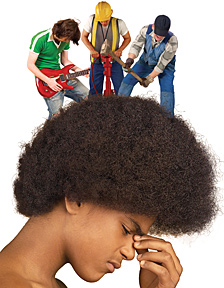Headache Hassles
And How to Deal With Them
By Dr. Kevin Wong
Do you or someone you love struggle with frequent headaches? You can probably hold up both hands and still not have enough fingers to count everyone you know who suffers from headaches at one time or another. We all seem to have that friend or co-worker who struggles with migraines. Of course, it could even be you!
Headache disorders are among the top 10 most disabling health conditions. They are extremely common, to say the least, and interestingly enough, women are affected by headaches more frequently than men. Globally, the percentages of the adult population with an active headache disorder are staggering: 46 percent for headache in general, 11 percent for migraine, 42 percent for tension-type headache and 1-3 percent for cluster headache.
Headache is defined as pain in the head or upper neck. It is one of the most common locations of pain in the body and has many causes. Typical types of headaches include migraine, tension and cluster headaches. There are also a variety of less common types of headaches. Headaches are quite a pervasive problem in modern society. Once the type is identified, there are a variety of treatment avenues one can go down. In the end, taking a natural approach can be extremely effective and may help you to relieve your pain without resorting to the all-too-common treatment option: over-the-counter pain medication.
 Which Type(s) of Headache Do You Get?
Which Type(s) of Headache Do You Get?
Tension headaches are the most common type of headache, and yet their causes aren't well-understood. A tension headache is generally a diffuse, mild to moderate pain that many people describe as feeling as if there's a tight band around their head. As many as 90 percent of adults will suffer one or more tension headaches. Tension headaches are more common among women than men.
Migraine headaches are the second most common type of headache. An estimated 28 million people in the United States (about 12 percent of the population) will experience migraine headaches at some point in their life. Migraine headaches affect children as well as adults. Before puberty, boys and girls are affected equally by migraine headaches, but after puberty, more females than males are affected. An estimated 6 percent of men and up to 18 percent of women will experience a migraine headache during their lifetime.
Cluster headaches are so named because the attacks come in groups. The pain arrives with little, if any, warning, and has been described as the most severe and intense of any headache type. It generally lasts from 30-45 minutes, although it might persist for several hours before disappearing. Unfortunately, the pain can recur later in the day. Most sufferers experience one to four headaches a day during a cluster period.
Cluster headaches frequently surface during the morning or late at night; the cluster cycle can last weeks or months and then can disappear for months or years. It is estimated that less than 1 percent of the population are victims of cluster headaches. More men (about five to one) than women suffer from cluster headaches.
There is no doubt that headaches of all types affect quality of life. Some people have occasional headaches that resolve quickly, while others are debilitated. Tension, migraine, and cluster headaches are not life-threatening. However, due to the quality and intensity of the pain, people often have trouble concentrating, and their work and home life suffer. In many cases, you hear of people having to go to sleep in order to make the headache disappear, which can be difficult to do when you're in pain.

